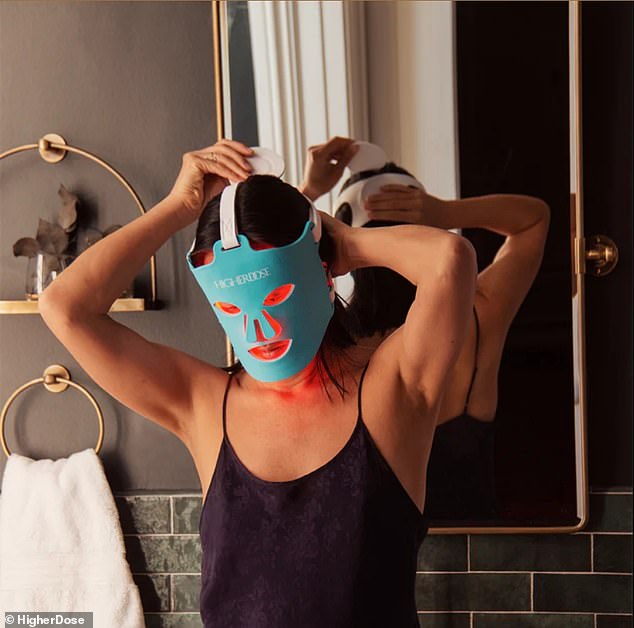Infrared masks and blankets sold at Sephora for up to $700 are loved by TikTokers, but studies show they’re not worth the hype
For more than 2,000 years, people have sat in hot, steamy, airless rooms in the name of wellness.
Saunas have long been enjoyed as a way to relax after a workout – and are said to provide a host of benefits, such as relieving pain and plumping the skin.
And now smart tech companies have developed a way to carry a sauna with you, in the form of a blanket.
Infrared sauna blankets are the latest wellness craze to take over TikTok, with more than 1.5 million videos on the topic.
The devices, which resemble a sleeping bag, use light waves to generate heat in the body instead of in the surrounding air, allowing the radiant heat to penetrate deeper into the body than a traditional walk-in sauna.
Now the world’s biggest warm blanket brand has just launched at cosmetics superstore Sephora – and it’s expected to According to industry sources, retail will generate up to $10 million in retail sales by the end of 2024.
Infrared sauna therapy claims to ‘detox’ the skin through sweating, lowering blood pressure and smoothing wrinkles. Fans also appreciate its ability to promote muscle recovery after exercise and reduce pain-causing inflammation
The HigherDOSE blanket, which costs $700, claims to aid post-workout muscle recovery and ‘detox’ the body.
Users online report improvements in their skin tone, overall stress levels and immune system, and compare the satisfying feeling when a 45-minute sauna session ends with that of a good workout.
And the range of infrared tools that are gaining popularity extends far beyond just blankets.
Sephora is selling a yoga mat-like infrared device and red light face and neck masks that, for $350, promise to “spark inner radiance with two powerful wavelengths of light (red/near-infrared) to stimulate skin cells, visibly smooth fine lines and target spots.”
HigherDOSE says their products introduce a ‘new way to achieve radiant skin through detox, recovery and longevity’.
But do these devices work? And are they worth the high price tag?

Infrared therapy claims to flush toxins from your skin through sweat and plump its surface via improved blood flow, promoting skin tone, elasticity and firmness
The majority of studies have been conducted on infrared saunas, rather than blanket-like devices. And the research has produced mixed results.
The benefits of infrared sauna therapy are said to lie in both the amount of sweat and the effect of heat on the blood vessels under the skin.
Extreme increases in temperature cause blood vessels to dilate or dilate, increasing blood flow to the skin’s surface. Research shows that this helps muscles recover after training and can strengthen the immune system, making you better able to fight infections. Increased blood flow to the skin can also have a plumping effect, smoothing lines and wrinkles.
Some studies have shown that this has a beneficial effect on blood pressure. A 2009 review published in the journal Canadian general practitioner found that infrared therapy may be useful in treating mild to moderate hypertension (high blood pressure). The researchers also found some small benefits for chronic pain.
But that analysis had several notable limitations, including poor study design, small sample size, and potentially unreliable symptom reporting.
Another small study on the impact of therapy on circulation found that men with coronary heart disease perceived risk factors improving function of their endothelium – cells that line the inside of blood vessels and play a crucial role in preventing potentially fatal blood clots.
However, there were only 25 men in this study, and they were only followed for two weeks.
As for the supposed cosmetic benefits of sweating (which is said to flush toxins from the skin), very few high-quality studies have found evidence to support this.
What about other effects on the skin?
Most devices for sale use a combination of infrared and red light therapy.
Red light does not generate heat, but uses low wavelength light to penetrate about two millimeters into the skin.
It is believed to benefit the skin by stimulating activity in the ‘power stations’ within the skin cells – a component called the ‘skin cells’ mitochondria. This supposedly accelerates healing and growth, improving skin rejuvenation.
The vast majority of studies on the impact of red light therapy on the skin involve small numbers of patients, and this is sponsored by companies that make light appliances.
A 2006 study published in the Yonsei Medical Journal found that two hours of infrared sauna therapy can triple the amount of collagen produced by the skin.
Collagen is the protein in the skin that gives it elasticity. It decreases with age, causing the skin to sag and become more wrinkled.
The researchers noted a 26 to 50 percent improvement in the appearance of fine lines and non-severe wrinkles. cThe rowing wrinkle showed minimal improvement.
Although promising, the study was small and involved only twenty women. Furthermore, the skin effects were only measured every four weeks over the course of six months – and many other factors could be behind the effects.
According to Dr. Mathew Avram, director of dermatologic surgery at Massachusetts General Hospital in Boston, the effects of infrared and right light masks, if any, would be modest at best when used for long periods of time.
‘If people see any improvement at all, what they might notice is improved texture and tone of their skin, maybe a little bit of a reduction in redness. But often any improvements are quite subtle and not always easy to detect,” he told Today.
Although some research has been done on infrared therapy, experts make it clear that more extensive research is needed before they can confirm the benefits.
